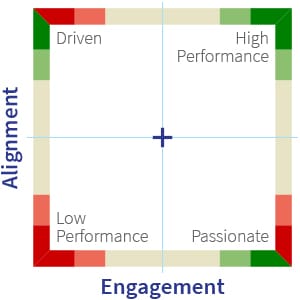Practical insights to foster employee engagement
Dive into our case study that uncovers the keys to fostering high employee engagement, embedding vision in company culture, aligning recruitment and enhancing ...
Benchmarking board performance: 500 board reviews later
Unlock evidence-based insights into board performanceUncover insights to help you increase your employee engagement.
Talk to us todayEmployee engagement is a holistic measure of how emotionally invested and actively involved employees are in their roles and the success of their organisation. It’s about feeling passionate about their job, being committed to the organisation’s goals, and having a sense of purpose and belonging.
An engaged employee is more likely to be productive and less likely to leave the company than a disengaged one.
Post-pandemic with a tight labour market, an all-time low unemployment rate, and increased demand for hybrid and flexible working conditions, more than ever, it is crucial to focus on employee retention.
That over 40% of the global workforce is considering leaving their employer this year? And that voluntary quitting has increased, along with employees’ confidence in being able to get another job as good as their current one (52%, +14%), and a job that pays as much as their current one (58%, +7%)?
However, it’s not all about wages.
Employee data collected from Insync’s Alignment and Engagement Survey (AES), during the pandemic, specifically highlighted that the key drivers of envisioning a fulfilling future at an organisation are based around investment in people and teams, followed by local leadership.
There are different ways to measure employee engagement. The top ones are:
Surveys are a widely used tool to measure employee engagement. These tools vary in their scope and frequency. They can be comprehensive, covering a broad range of topics in annual surveys, or they can be more frequent, like pulse surveys, which focus on specific issues and provide immediate feedback.
These surveys typically consist of questions about the employee experience, job satisfaction, workplace environment, and more, providing a broad overview of employee sentiment.
The true value of using Insync’s Alignment and Engagement Survey is the ability to identify alignment and engagement and its drivers within a highly robust and valid framework.
You can also customise, remove and add items to ensure your survey is fit for your purpose and circumstances. Most importantly, when we provide you with benchmarked survey results we can provide you with a roadmap for success – a prioritised list of improvement opportunities that will improve your organisation’s performance.
And why independently administered? Because research suggests that in-house surveys show biased results, with employees giving higher scores (often in fear of repercussions). Whereas employees tend to be much more candid when responding to a survey run by a party considered to be independent – thus the results are more accurate.


eNPS is a quick survey with a single question: how likely are employees to recommend the organisation as a workplace? This score can be a straightforward indicator of overall employee sentiment and engagement, providing a quick snapshot of how employees feel about the company.
Then, the answers can be followed up with another assessment tool to understand issues better.
Interviews offer a more personalised approach to measuring employee engagement. Conducting one-on-one interviews with employees allows a deeper exploration of their feelings, attitudes, and perceptions about their work and the organisation.
Interviews can take the form of either stay interviews or exit interviews. Stay interviews are for current employees to understand their reasons for staying with the organisation and identify factors contributing to their engagement and satisfaction. These proactive interviews address potential issues before they lead to disengagement or turnover.
Exit Interviews, on the other hand, are conducted when an employee decides to leave the organisation. They reveal why employees may become disengaged and choose to leave. They can provide honest feedback about the organisation, which might not be captured through other means due to the lack of repercussions for the departing employee.
Focus groups are also interviews in a group setting to discuss and explore common themes and issues related to their work and the organisation.
The interactive nature of this format fosters open dialogue, creating a space that encourages shared experiences and collective insights–insights that individual interviews or surveys might not typically uncover.
Another critical metric in understanding employee engagement is the retention and turnover rate. Looking at how many people stay or leave a job is essential for understanding if employees are happy and engaged.
High turnover rates can be a red flag, indicating low employee engagement and satisfaction. On the other hand, a strong retention rate suggests a positive work environment where employees feel valued and motivated to stay.
This analysis can then be complemented with other employee engagement measurement tools, such as surveys, interviews, or focus groups to explore issues more thoroughly.
Carrying out an independent benchmarked survey that has been designed to meet your requirements is only the first step. Our mantra is less measurement and more improvement, not the other way around. Many organisations have been doing employee engagement surveys for years with little or no improvement in employee engagement.
Unlike other survey companies, Insync is also there to help you improve. Whether you use our Alignment and Engagement Survey or another well-designed and independently administered survey, we can provide expert advice on how to interpret and act on your results.
With 3 years of employee turnover at 57% costing an estimated $2.9 million each year, West Arnhem Regional Council (WARC) knew there was a need for change. Insync was selected to partner with WARC in their critical improvement journey measuring levels of employee alignment and engagement, resulting in reduced employee turnover by 25% and millions saved each year. You can read our exclusive case study here.
Click below to download our employee engagement offering guide. Alternatively, click here for a video overview.
Dive into our case study that uncovers the keys to fostering high employee engagement, embedding vision in company culture, aligning recruitment and enhancing ...
Through analysis of over 40,000 employee survey responses we uncovered what makes people stay, along with 6 strategies to improve employee retention.
Many organisations across the globe are implementing cultural change programs to become more customer centric (discussed in our article The 6 essential ingredients ...
Discover the differences between psychosocial hazards and psychological safety, and why having a balance of both is crucial for employee wellbeing.
We use cookies to enhance your experience. Further use is considered consent. You can read more about cookies in our Privacy Policy.


You’ll always get a real person when you contact Insync.
Let's get started